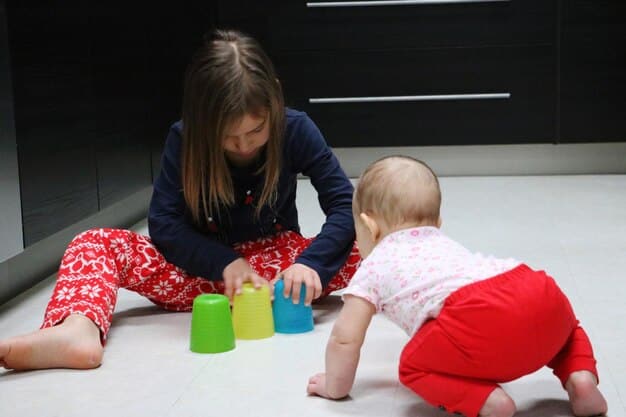Decoding Infant Cues: A Parent’s Guide to Understanding First Year Needs

A comprehensive understanding of infant cues in the first year is crucial for parents to effectively recognize and respond to their baby’s developmental needs, fostering a strong bond and supporting healthy growth and well-being.
Embarking on the journey of parenthood is a profound experience, filled with immense joy, boundless love, and a unique set of challenges. Among these, perhaps none is as foundational as learning to communicate with a new human being who primarily expresses their needs and emotions through non-verbal signals. Decoding Infant Cues: A Parent’s Guide to Understanding Developmental Needs in the First Year offers an essential roadmap for parents navigating this intricate silent language, transforming confusion into connection and fostering a responsive, nurturing environment for their baby’s crucial first twelve months.
The Silent Language: Why Understanding Cues Matters
Infants, in their earliest stages of development, communicate volumes without uttering a single word. Their cries, movements, facial expressions, and even subtle shifts in breathing patterns serve as a rich tapestry of messages, each one a vital clue to their immediate needs or developmental state. For new parents, recognizing and accurately interpreting these signals is not merely about comfort; it’s about building a foundation of trust, promoting healthy attachment, and ensuring the baby’s fundamental needs for nourishment, sleep, security, and stimulation are met.
Ignoring or misinterpreting these cues can lead to frustration for both parent and child. A baby who is consistently misunderstood may struggle with self-regulation, while parents might experience increased stress and feelings of inadequacy. Conversely, a parent attuned to their infant’s unique communication style can respond proactively, preventing distress and fostering a sense of security and responsiveness that is paramount for early brain development and emotional well-being.
The Foundational Principles of Infant Communication
At its core, infant communication is an intricate dance of action and reaction. Babies are constantly observing their environment and responding to it, offering parents a window into their internal world. Key principles guide this understanding:
- Predictability and Pattern Recognition: While each baby is unique, many cues fall into predictable patterns related to hunger, sleepiness, discomfort, or overstimulation. Learning these patterns is key.
- Context is King: A cry means different things depending on the time of day, the baby’s last feeding, or the surrounding environment. Always consider the full picture.
- Evolution of Cues: As infants grow, their cues evolve. A newborn’s sleepy cues might be subtle yawns, while an older infant might rub their eyes vigorously.
Mastering the art of cue decoding is an ongoing process of observation, experimentation, and learning. It’s about more than just reacting to a cry; it’s about anticipating needs, understanding developmental milestones, and responding in a timely and sensitive manner that builds a strong, reciprocal relationship.
Early Cues: Decoding Hunger, Sleep, and Comfort
The first few months of an infant’s life are primarily dominated by fundamental needs: hunger, sleep, and the desire for comfort and security. Learning to differentiate between these early cues is often the most immediate challenge for new parents, yet it’s crucial for establishing healthy routines and a sense of predictability for the baby.
Hunger cues typically progress in intensity. Early signs might include lip smacking, rooting (turning their head towards a touch on the cheek), or bringing hands to their mouth. If these early signals are missed, the baby might progress to fussiness, then agitated movements, and finally, a full-blown cry. Responding during the early cues helps prevent overwhelming distress and makes feeding a more positive experience for both parent and child.
Recognizing the Signs: Hunger vs. Sleep vs. Discomfort
Distinguishing between these basic needs requires careful observation. While a crying baby might seem to indicate any of these, specific nuances in their body language offer clues.
- Hunger Cues:
- Early: Rooting, lip smacking, mouth movements, bringing hands to mouth.
- Mid: Fussiness, squirming, soft cries, trying to suck on anything nearby.
- Late: Loud, intense crying, frantic head movements.
- Sleep Cues:
- Early: Yawning, rubbing eyes, dulling of attention, less active.
- Mid: Fussiness, jerking movements, arching back, disinterest in play.
- Late: Crying, difficulty settling, prolonged fussiness.
- Discomfort Cues (Gas, Wet Diaper, Temperature):
- General fussiness, grimacing, arching back, pulling legs up to chest (gas).
- Shivering or sweating, flushed cheeks (temperature).
- Irritability and wiggling (wet/dirty diaper).
Paying close attention to the sequence and combination of these cues, rather than just one isolated signal, will greatly enhance a parent’s ability to respond appropriately. This responsive caregiving not only meets the baby’s immediate physical needs but also reinforces their sense of security and trust in their caregivers, laying the groundwork for positive emotional development.
Developmental Milestones and Evolving Communication
As infants grow and develop through their first year, their communication methods become more sophisticated and varied. This evolution is directly linked to their cognitive and physical milestones. What begins as reflexive actions soon transforms into intentional gestures, sounds, and interactions. Understanding these developmental stages helps parents anticipate new forms of communication and adjust their responses accordingly.
For instance, around 2-3 months, babies often begin to coo and babble, making vowel sounds and exploring their vocal cords. This is their precursor to language. By 4-6 months, they may start experimenting with consonant-vowel combinations (“ba-ba,” “ma-ma”) and show increasing interest in interactive play. Their ability to reach for objects, follow gazes, and smile intentionally also becomes a powerful form of communication, indicating curiosity, enjoyment, or a desire for interaction.

Age-Specific Cues and Their Meanings
The first year is a period of rapid change, and so too are the ways babies communicate. Tailoring your response to their current developmental stage is key.
- 0-3 Months: Primarily reflexive cries and movements. Focus on differentiating hunger, pain, sleepiness. Early social smiles emerge.
- 3-6 Months: Cooing, babbling, more expressive facial reactions. Reaching intently for objects. Laughing and squealing indicate joy. Curiosity cues: wide eyes, focused gazing.
- 6-9 Months: Intentional gestures like waving “bye-bye” or pointing. Responding to their name. Stranger anxiety or separation anxiety may emerge, expressed through clinginess or crying. Sounds become more varied.
- 9-12 Months: Mimicking sounds. Using simple words like “mama” or “dada” with intention. Pointing to desired objects. Playing games like peek-a-boo, indicating understanding of social interaction. Showing preferences for certain foods or toys.
Each new milestone brings a new layer to an infant’s communicative toolbox. Parents who observe these changes and adapt their interactions will naturally foster a richer communicative environment for their child, encouraging further development and strengthening their bond.
Beyond Basic Needs: Expressing Emotions and Overstimulation
While hunger and sleep are primary drivers of infant communication, babies also express a wide range of emotions and reactions to their environment. Learning to distinguish between a cry of frustration, sadness, discomfort, or even overstimulation requires a nuanced approach and keen observation. An infant’s emotional landscape is surprisingly complex, and recognizing these non-verbal emotional cues is vital for responsive parenting.
An infant who is overstimulated, for example, might turn their head away, grimace, stiffen their body, or become fussy shortly after being in a noisy or busy environment. These cues signal a need for quiet, gentle comfort, and a return to a calmer state. Conversely, a baby who is bored might fuss, look away, or try to gain attention with sounds, indicating a need for new stimulation or interaction.
Decoding Emotional Registers and Overload Signals
The ability to read beyond basic needs into the emotional state of an infant significantly enhances a parent’s capacity for empathetic and effective caregiving.
- Happiness/Contentment: Smiling, cooing, relaxed body, bright eyes, engaging with caregivers.
- Frustration/Anger: Stiffening, arching back, red face, sharp or angry cries, pushing away. This can happen during feeding if flow is too slow/fast, or if play is interrupted.
- Sadness: Quivering lip, long drawn-out cries, slumped posture, less active. Often seen when tired or seeking comfort after a mild disappointment.
- Pain/Discomfort: Intense, piercing cries, often sudden, accompanied by specific body language like drawing knees to chest (gas), arching back, or rigid limbs.
- Overstimulation/Distress (Look Away Cues):
- Gaze aversion: Turning head away, avoiding eye contact.
- Becoming fussy or irritable after a period of intense activity or stimulation.
- Yawning, rubbing eyes, or jerking movements when not sleepy but overwhelmed.
- Hiccups or sneezing can sometimes be signs of a baby trying to regulate their system after being overstimulated.
Understanding these emotional cues empowers parents to not only soothe their infant but also to understand the context of their emotional experiences, laying the groundwork for emotional intelligence and resilience as the child grows.
The Role of Parental Responsiveness and Attachment
The concept of “responsive parenting” is intrinsically linked to understanding infant cues. It’s about recognizing the baby’s signals and responding to them consistently and appropriately. This consistent responsiveness is not about immediately eliminating all discomfort, but about acknowledging the baby’s communication and meeting their needs in a way that builds a secure attachment. Secure attachment, characterized by a child’s confidence that their caregiver will be there for them, is crucial for long-term emotional and social development.
When parents consistently respond to their infant’s cues, the baby learns that their world is a safe and predictable place where their needs will be met. This fosters a sense of security, encouraging them to explore their environment with confidence, knowing they have a reliable base to return to. In contrast, inconsistent or unresponsive care can lead to insecure attachment, potentially impacting the child’s emotional regulation and relationships in the future.
Building a Secure Foundation Through Responsive Care
Responsive caregiving goes beyond just reacting; it involves observation, interpretation, and appropriate action. It’s a dynamic process that evolves as the baby grows.
- Observe Closely: Pay attention to subtle changes in facial expressions, body tension, gaze direction, and vocalizations.
- Interpret Accurately: Consider the context. Is it time for a feed? Are they tired? Too warm? Bored?
- Respond Appropriately: Your response should match the cue. If they are hungry, feed them. If they are overstimulated, provide calm. If they need connection, engage them.
- Consistency: While perfection isn’t expected, consistently striving to meet the child’s needs helps build a strong foundation of trust.
This dynamic interplay between infant cues and parent response forms the bedrock of a healthy parent-child relationship. It empowers the infant to communicate effectively and teaches parents how to read their unique child, creating a harmonious and supportive environment for thriving.
Practical Strategies for Decoding and Responding
While understanding the theory behind infant cues is valuable, parents often seek practical strategies to hone their decoding skills and respond effectively. It can feel overwhelming at first, but with patience and practice, these skills become second nature. One of the most effective strategies is to engage in mindful observation, treating each interaction as a learning opportunity. Keep in mind that every baby is an individual, and what works for one may not work for another.
Establishing a calm and attentive environment is key. Minimize distractions when interacting with your baby, allowing you to fully focus on their signals. Consider keeping a mental (or even written) note of patterns you observe – for example, how your baby typically acts when they’re getting sleepy, or what their “hungry cry” sounds like distinctly from a “discomfort cry.” This personalized database of cues will be your most valuable tool.
Tips for Becoming a Cue-Decoding Expert
Becoming adept at reading infant cues is a skill that develops over time, but these strategies can accelerate the learning process:
- Start Early and Observe Often: Begin practicing cue recognition from day one. The more you observe, the better you’ll become at noticing subtle shifts.
- Rule Out the Obvious: Before trying complex solutions, always check the basics: Is the diaper wet? Are they hungry? Are they too hot or cold?
- Experiment and Learn: Try different responses to similar cues. For example, if your baby is fussy, offer a feed, then a diaper change, then cuddling, and observe which response brings comfort quickest.
- Use the “Pause” Technique: Instead of immediate action, sometimes a momentary pause (a few seconds) can allow the baby to give you a clearer signal.
- Trust Your Instincts: Parental intuition is powerful. If something feels “off” or different about a cue, trust that feeling and investigate further.
- Seek Support: Don’t hesitate to consult with pediatricians, lactation consultants, or experienced parents if you’re struggling to understand your baby’s needs.
Remember, parental responsiveness isn’t about perfectly predicting every need, but about consistently trying to understand and meet them. This journey of mutual learning strengthens the bond and creates a harmonious foundation for both parent and child.
Common Challenges and Misconceptions in Cue Decoding
Despite the wealth of information available, parents often face significant challenges and misconceptions when it comes to decoding infant cues. One common pitfall is the tendency to immediately attribute all infant fussiness to hunger, leading to overfeeding and potential digestive discomfort. Another is the belief that allowing a baby to “cry it out” from a very young age teaches independence, when in fact, consistent responsiveness in early infancy is crucial for building security and self-regulation skills.
The sheer volume of advice, often conflicting, from various sources can also create confusion. Social media, well-meaning relatives, and online forums often offer anecdotal rather than evidence-based guidance, making it difficult for parents to discern reliable information. It’s important to approach cue decoding with a critical mind, prioritizing scientific understanding and expert advice over popular myths.

Debunking Common Myths and Overcoming Hurdles
Addressing these challenges is essential for effective cue decoding and nurturing care.
- Myth: All Crying Means Hunger. Reality: Crying is a baby’s primary form of communication for *all* needs – hunger, sleep, discomfort, overstimulation, boredom, or simply the need for connection.
- Myth: Always Pacify Immediately. Reality: While responsiveness is key, sometimes a moment of observation helps differentiate cues. Also, it’s okay for a baby to be momentarily fussy; the goal is to respond appropriately, not eliminate all fussiness.
- Challenge: Overtiredness Leads to Hyperactivity. This isn’t a myth, but a common difficult-to-decode cue. An overtired baby often becomes wired and agitated, making it harder to put them to sleep, rather than simply shutting down.
- Challenge: Growth Spurts and Wonder Weeks. These periods bring increased fussiness, changed sleep/feeding patterns, and new developmental breakthroughs. Knowing these periods helps parents understand why cues might intensify or change suddenly.
- Misconception: Cues Are Universal. While basic cues exist (e.g., rooting), *how* a baby expresses them is unique. One baby might rub their face gently, another furiously rub their ears when sleepy.
Arming oneself with accurate knowledge and patience, and understanding that every baby is unique, can help parents navigate these common hurdles. Ultimately, the goal is to develop a deep, personalized understanding of one’s own child.
| Key Point | Brief Description |
|---|---|
| 👶 Non-Verbal Communication | Infants use cries, movements, and expressions to signal needs and emotions. |
| ⏱️ Early Cue Recognition | Distinguish hunger, sleep, and discomfort to prevent distress. |
| 📈 Evolving Cues | Cues change with developmental milestones; adapt your responses accordingly. |
| 🤝 Responsive Parenting | Consistent, appropriate responses build trust and secure attachment. |
Frequently Asked Questions About Infant Cues
Hunger cries often start as fusses, accompanied by rooting or hand-to-mouth movements, and escalate to insistent cries. Discomfort cries, such as for gas or a wet diaper, may be more sudden, sharper, or accompanied by specific body language like arching the back or pulling legs to the chest. Observing the sequence of cues and considering the last feeding time helps differentiate.
Yes, yawning combined with fussiness, hyperactivity, or difficulty settling down are classic signs of overtiredness. Infants, especially newborns, have very short wake windows. Missing their sleepy cues can lead to a surge of cortisol, making it harder for them to relax and fall asleep. Establishing a consistent sleep routine can help prevent this.
Initially, cues are mostly reflexive. As infants grow, their communication becomes more intentional. Around 3-6 months, they’ll use coos, babbling, and reaching. By 6-12 months, they may point, wave, mimic sounds, and use simple words. Their emotional expressions also become more distinct, showing specific joy, frustration, or sadness.
Gaze aversion is when an infant turns their head away or avoids eye contact. This is a common cue signaling that they are overstimulated, tired, or need a break from interaction. Responsive parents respect this cue by reducing stimulation or offering a quiet moment, helping the baby self-regulate and avoid distress.
No, it is generally not possible to “spoil” a baby by responding to their cries in the first year. In fact, consistent and timely responses to an infant’s cues build trust and secure attachment, which are crucial for healthy emotional and cognitive development. Responsiveness teaches babies that their needs will be met, fostering a sense of security and confidence.
Conclusion
Embarking on the journey of parenthood means entering a new world of communication, one where understanding goes beyond words. Decoding Infant Cues: A Parent’s Guide to Understanding Developmental Needs in the First Year serves as an invaluable resource in this endeavor, empowering parents with the knowledge and confidence to interpret their baby’s unique language. By attentively observing, empathetically responding, and continuously learning from these subtle signals, parents not only meet their infant’s immediate needs but also build an unbreakable bond of trust and security. This foundation of responsive care is critical, fostering a nurturing environment where infants can thrive emotionally, physically, and cognitively, truly setting the stage for a lifetime of healthy development.





